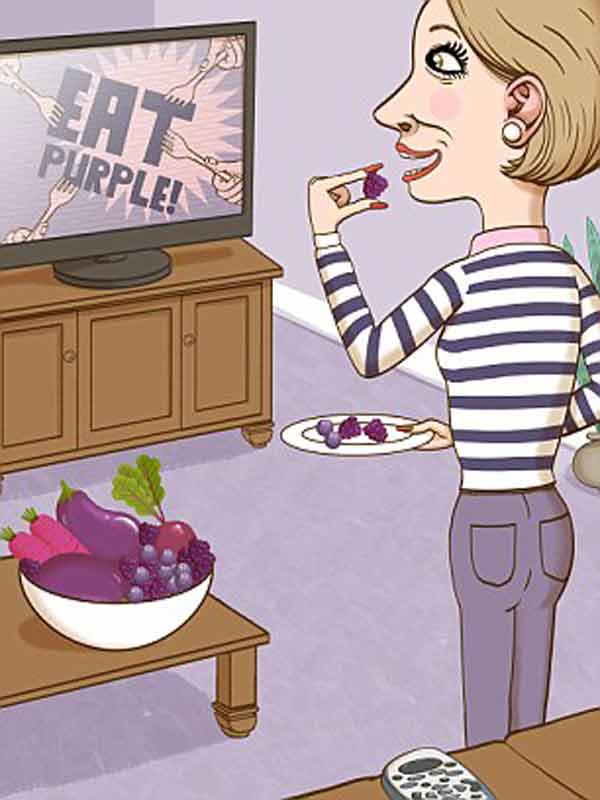Oxford, UK (BBN) – In this important new series, an Oxford professor reveals that if you look after yourself in middle age, it will help you stay fit and well when you’re old.
Dr Muir Gray showed how easy it is to recharge your life, reports dailymail.co.uk.
Today he tackles healthy eating…
After the age of 40, the penny begins to drop.
By then, you may have had a health scare.
You’ve probably started using reading glasses and your jeans are too tight.
You are, in short, no longer young.
You’ve reached the foot-hills of mid-life — and it’s all downhill from there.
That’s what many people tell themselves, but it certainly doesn’t have to be that way.
On Saturday, I explained how, if we rid ourselves of our bad habits from 40 onwards, we have a far greater chance of a healthy, disease-free and active old age.
In addition, you need to eat more of the right foods and fewer of the ones that are bad for you.
Sounds simple, doesn’t it? After all, there are hundreds of diets out there, all claiming to be the last word in healthy eating.
But which one should we trust?
Well, I’ll come to that soon.
But first, an inconvenient fact: when it comes to strong scientific evidence on what does you good, there’s far more on exercise than on food.
So it’s little wonder that experts differ on which foods you should eat more of.
Fortunately, however, they’re remarkably consistent on what you should consume less of.
And the easiest way to describe that is: Eat Less Rubbish.
Americans probably eat more ‘rubbish’ than anyone else on the planet — as the sign ‘Deep-Fried Dough’ at every baseball stadium will testify.
Yet Britain is now close behind in the race to become the most obese nation on Earth.
And it’s not just obesity that’s the problem.
Eating ‘rubbish’ also increases the risk of developing serious diseases in later life, as well as making you feel less healthy in mid-life.
12 SIMPLE WAYS TO LOSE WEIGHT
1. Weigh yourself at the same time each week.
2. Start getting fitter at the same time as you start eating less.
3. Find yourself a support network .
You could join a group such as Slimming World or Weight Watchers or the Hairy Bikers’ Diet Club.
Or just start a group with friends or colleagues who also want to lose weight.
4. Make sure you get enough sleep
5. Sit down to eat, even if you’re very rushed.
6. Use smaller plates.
7. Sit still and concentrate for a minute before you start eating.
8. Put your knife and fork down after each mouthful.
9. Don’t read or watch TV when you’re eating — otherwise you can finish up with an empty plate but no memory of having eaten anything.
10. Do less sitting. If you have to spend time at a computer, sit less and stand more
11. Use the Sugar Smart app to check how much sugar a packet contains.
12. Reward yourself with (non-food) pleasures.
This isn’t a vague warning — there’s plenty of scientific evidence to back it up.
It’s been shown, for instance, that if you persist in eating ‘rubbish’, particularly after the age of 40, you’re putting yourself at risk of having a stroke or contracting type 2 diabetes, heart disease, high blood pressure and some cancers — notably breast and colorectal.
Are you at risk yourself? To check, be honest about how often you consume the following.
Against each item, score 3 for ‘most days of the week’, 2 for ‘some days a week’, and 1 for ‘never’.
Biscuits
Sweets
Salty packaged snacks
Sweet packaged snacks
Cans of sugar-rich soft drinks
• If you scored 6, well done!
• Under 12? There’s scope for eating better and feeling better.
• More than 12 but less than 15? You need to take action.
You scored 15? You urgently need to get a grip — you’re consuming way too much salt and sugar.
So my first important message is simple: in mid-life especially, you need to consume less salt and sugar.
Which is why number one on my ‘eat less’ list is anything that comes in a shiny package near to the till.
You should also be aware that one of the biggest sources for both salt and sugar is ready-made food, so always try to study the ingredients on the packaging before slinging it into your shopping trolley.
You can also use the new Sugar Smart app from Public Health England to check just how much sugar is in a package or bottle.
Now, let’s take a look at whether you need to change anything else in your diet, whether it’s to reduce the risk of disease, to lose weight, to make your skin look more youthful or to help you feel more energetic.
Fortunately, all these aims require roughly the same changes — so first, consider the following questions:
Do you weigh more than at age 30?
Are you now buying trousers with a bigger waist, or a larger dress size than you did at 20?
When you look at yourself naked in a mirror, do you think you would look better with less weight?
If you answered ‘yes’ to one or more of the questions, you need to adjust your diet, or you’ll be at least 5 kilos (11 lb) heavier at 60, and 10 kilos (22 lb) heavier by 70.
The increase in weight that often takes place from mid-life onwards is certainly not inevitable.
It’s almost always due to both an increased intake of food or alcohol, coupled with decreased physical activity.
The solution is increased energy expenditure and decreased energy intake.
Or to put it simply: move more and eat less.
Moving more should, at the least, mean walking for 30 minutes extra five days a week — and making sure you get breathless twice a week.
Apart from building up your stamina, this will help you lose weight and prevent you regaining the weight you’ve lost.
But even that is not enough: to burn more calories, you also need to stand every hour for at least five minutes.
You should also try doing a lot of little stand-ups – for instance, during a TV ad break.
What if you think you have a genetic predisposition to put on extra weight?
That’s not actually as daft as it sounds, because it’s only in the past few centuries that our food supply in winter has been secure.
Before that, it was a positive advantage to lay down fat in anticipation of the lean times.
That’s why people whose genetic code allowed them to deposit more fat when there was a food surplus were more likely to survive and breed.
So it may possibly be that you’re one of their descendants.
Still, this is no excuse for not losing weight: it simply means you need to be more vigilant.
It means reducing your intake of foods that are low in volume and high in energy.
The volume bit is important because if your stomach doesn’t feel almost full, you’ll feel hungry soon afterwards.
You must also eat less of — and ideally stop eating — the junk food I listed earlier.
It’s important to remember that alcohol, which many of us turn to regularly in mid-life, is calorie-rich as well as bad for your health above certain levels.
Cutting back on your drinking in mid-life makes good sense anyway, because your body is no longer as resilient as it used to be and the effects of alcohol are more powerful.
The latest guidelines from the Department of Health warn us not to drink more than 14 units a week, which adds up to:
• Six pints of beer; OR
• Seven 175ml glasses of average-strength (12 pc) wine; OR
• 14 single shots of spirit
Remember to space out your drinks over the week, and always try to have at least two alcohol-free days a week.
It’s a good move, too, to stop drinking for the whole of January (or, indeed, any month) because alcohol is so rich in calories.
So what should we be eating in our daily diet?
Is there anything out there that’s proven to make us both healthier and younger-looking?
Every month, new miracle diets appear and they usually focus on some particular food — red meat, say, or cheese or tofu or fish — that should be eaten in greater or lesser quantities. Much of this is merely wishful thinking.
However, what almost all ‘miracle’ diets have in common is that they include the principles of the Mediterranean diet: the food that’s eaten in Italy, France, Greece, Spain and other countries on the northern shores of the Mediterranean.
In study after study, this diet has consistently been associated with good health.
For example, a 2013 study found that people following the Mediterranean diet had a 30 per cent lower risk of heart disease and stroke.
It’s tasty and easy to follow because the following foods can be eaten in abundance:
• Fruit and vegetables: Not just five portions a day but seven if you wish.
When possible, eat purple. Purple foods are associated with a longer life because they contain polyphenols, so eat more red cabbage, blackcurrants and blueberries.
• Nuts, peas and beans: For their low-fat protein.
• Brown bread, brown rice and other wholemeal food and grains: For their fibre
• Pulses and lentils: For the chemical called inulin.
• Olive oil: For the unsaturated fats it contains.
It’s important to incorporate as many of these fas possible in your everyday diet.
Simply get into the habit of eating the right things most of the time.
With that in mind, here are a few important tips for whenever you go food-shopping:
• Avoid anything containing white flour. Wholemeal is best.
• Reduce saturated fats, found in red meat, butter and cream. Eat poultry or oily fish instead.
• Increase unsaturated fats from plants — notably olive oil or oil from nuts.
Not all vegetable oil is recommended: avoid corn oil, for example.
• Try to eat oily fish — salmon, mackerel or tuna (fresh not tinned) — at least twice a week.
• Avoid hydrogenated fat or ‘trans fat’ — it’ll be on the label.
Traditionally, the Mediterranean diet includes a daily glass of red wine — but this doesn’t appear to be essential (and in any case, you should abstain for at least two days each week).
Here’s the good news: provided you don’t exceed the weekly limit of 14 units of alcohol, red wine does have some beneficial effects on the health of your heart.
This is because chemicals called polyphenols, found in much higher concentration in red wine than white, cause blood vessels to dilate and protect cells from harmful chemicals.
The not-so-exciting news is that plenty of other foods contain polyphenols.
So you get the same effect by having, for instance, a bowl of cranberries, a handful of walnuts or a strong cup of tea.
Finally, there’s one more thing to bear in mind — and that’s how much you eat in one sitting.
In Okinawa, the Japanese island known for the longevity of its population, people repeat a few words before they start to eat: hara hachi bu.
This reminds them that they’re not going to carry on scoffing until they’re completely full, just 80 per cent full. It works for them — and it might even help you fit into that tight pair of jeans.
FIVE CULPRITS THAT MAY BE WRECKING YOUR SLEEP
Many mid-lifers find it difficult to get enough sleep, particularly those who are always busy.
And if you don’t sleep long enough, not only will your quality of life be affected, but your behaviour will change.
Indeed, some of the problems that people put down to ‘old age’ are simply due to lack of sleep.
Ideally, you should be aiming for at least seven hours of oblivion a night for at least five nights a week.
So what is it that makes you toss and turn and find it so hard to switch off? Essentially, there are five causes of poor sleep:
1. CAFFEINE/ALCOHOL
Chemicals in the brain can cause sleep problems, particularly caffeine but also recreational drugs such as alcohol.
The older your brain, the more sensitive it becomes to the effects of chemicals.
So go easy on the wine at night, and make sure you stop drinking tea or coffee by 6pm at the latest (though some people need to stop much earlier in the day).
Prescribed medicines can also keep you awake: usually ‘sleeping difficulties’ are listed as a possible side-effect in the leaflet in the box.
Ask your pharmacist for advice and, if necessary, go back to your GP for an alternative.
2. ANXIETY/STRESS
Most of the time, insomnia is linked to psychological problems such as anxiety and stress, which can both be at a premium in mid-life.
People who are anxious find their minds going over and over certain issues: ‘Should I take that job offer?’; ‘How are we going to pay all the bills next month?’; ‘Why does our relationship feel strained?’
Sleeping pills may help in the short term, but the best way to improve your sleep is by using relaxation techniques such as breathing in and out slowly and deeply, saying ‘Breathe in, breathe out’ to yourself as you do so.
3. POOR SUPPORT
One environmental factor that often gets overlooked is your mattress.
These age, just like human beings, and it could be that yours is no longer up to the job, or offering your sleeping body proper support.
There’s no rule about how hard or soft a mattress should be — it just has to be right for you.
If you sleep with a partner, a zipped pair of single mattresses, one soft and the other firm, could well be the answer.
Alternatively, some manufacturers make double and kingsize mattresses with one half soft and the other medium, or they are split medium/firm.
Your social environment can also cause sleep problems, such as having children who wake early or teenagers who come in late.
4. INACTIVITY
Getting fitter and being active will most certainly help you to sleep better, even if you have arthritis, though most experts advise against vigorous exercise before bed.
What can help, though, is yoga, tai chi, Pilates or the Alexander Technique.
Try a few exercises or just do some stretching for five minutes every night.
Finally, for some people, the main problem is night-time itching.
A generous application of aqueous cream is effective in reducing this.
5. LACK OF ROUTINE
There’s evidence that a regular bedtime helps children get off to sleep, often accompanied by a bedtime ritual — a bath, a story, a kiss, a whispered ‘love you’.
For adults, too, the lack of a bed-time routine can be the principal cause of sleep problems.
BBN/MS/ANS

No Subscription? You Are Missing Out!
Join the business leaders of Bangladesh who rely on BBN's original reporting and in-depth analysis on business scenario of the country. We send only one daily email. No Spam Guaranteed!









